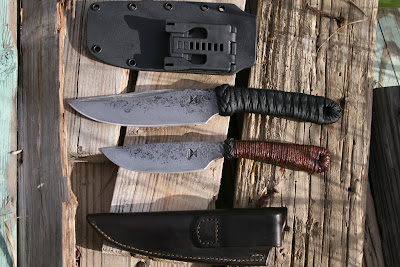THERE WILL BE AN ADJUSTMENT IN PRICES AFTER THE BLADE SHOW! Read about it here: http://helmforge.blogspot.com/2017/05/blade-show-2017-price-announcement.html
These are minimum prices. Depending on design, features, and materials, your price may be higher. Prices do not include shipping.
These are minimum prices. Depending on design, features, and materials, your price may be higher. Prices do not include shipping.
At this point I have no interest in making mirror or satin finished blades. I prefer the practicality and aesthetics of a forge finish, and frankly no customer has wanted to order anything from me that wasn't forge finished in a while. Every knifemaker has his area of focus, and mine will be on forge finished blades. Axes are a bit different and tend to have smooth-ground finishes.
A forge finish is easy to maintain and is difficult to damage. Many people, including myself, enjoy the primal look. A good forge finish displays the smith's skill with a hammer. It is smooth, showing no random hammer blows, textured only by the scale that forms from heating the steel to be able to hammer it into shape. I soak my forge finished blades in vinegar overnight in order to eat the scale off, leaving the textured steel exposed.
Steel will be 80CrV2 for knives and 4140 for axes, unless otherwise discussed. Handles can be wood, Micarta, natural cord wrap, or hardened paracord wrap. I make my own Kydex sheaths and work with several different leatherworkers to make make leather sheaths if desired.
Kydex sheaths are typically $40, not including carry hardware, with sheaths for longer blades starting at $50. Leather prices vary depending on maker and design. I have no markup on leather sheaths; typically I pay the leatherworker and then charge the customer what it cost me, although I will put a customer in direct contact with the leatherworker if so desired and they can pay directly if they would rather.
A fully sharpened top edge adds $30 to the base price for shorter blades, and $50 for longer blades.
$165 - 4"-5.5" knives. These are hand forged works of functional art. Very capable tools, they are also beautiful. I will work with you on design and materials to make your own knife that will serve you well the rest of your life. The knife will be delivered shaving sharp.
Cord wrapped handles start at $165 and Micarta or wood handles start at $185.
$185 - 6"-10" These are predominantly camp knives and fighters. Camp knives, used for chopping primarily, are typically balanced so that the blade is heavier. Fighters are more balanced between the handle and the blade, keeping them quick and lively in the hand in spite of the length of their blades.
Cord wrapped handles start at $185 and Micarta or wood handles start at $205.
$300+ - 10"+ Big choppers, machetes, and swords. Serious brush tools. Zombie killers.
Some options to consider:
Bolster - I put these on hidden tang knives but not on full tangs. The bolster is the metal support that strengthens the end of the wooden handle where the tang enters the wood. An actual bolster is the same basic cross section as the handle behind it. A single guard drops down on the edge side of the knife, helping keep the user's hand from sliding onto the blade. A double guard rides above the spine of the blade as well, really locking the user's hand from forward movement. I use either copper or steel for my bolsters and guards. A bolster will cost less than a single guard, which will in turn cost less than a double guard.
Lanyard hole - This allows you to add a lanyard for either added retention, aid in pulling the blade from the sheath, or simply decoration.
Handle material - There are many kinds of materials out there. Some of the most beautiful exotic hardwoods are also the most rare, and will have a higher materials cost.












.JPG)
.JPG)


